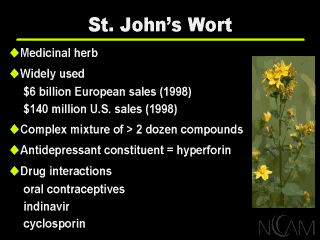| front |1 |2 |3 |4 |5 |6 |7 |8 |9 |10 |11 |12 |13 |14 |15 |16 |17 |18 |19 |20 |21 |22 |23 |24 |25 |26 |27 |28 |29 |review |
 |
Iím going to begin by summarizing work thatís being done
related to herbal medicines. I mentioned our study with the National Institute of Mental
Health of St. Johnís Wort. Let me give you some background and some idea of what weíre
trying to achieve here. This is a medicinal herb thatís incredibly popular with $6
billion of sales in a single year in Europe by this survey in 1998. Itís used primarily
for treatment of depression, other mood disorders -- anxiety disorders, many other
conditions. Like all plants, itís a complex mixture of many chemical constituents. We know that at least one of those constituents, hyperforin, contributes to its antidepressant action, and we have learned that St. Johnís Wort, while it may be active in depression and other clinical conditions, also interacts with drugs: birth control pills, AIDS drugs, and drugs important for preserving the survival of transplanted organs. Now, itís the background suggesting that St. Johnís Wort was effective for depression that led my colleagues in 1998 to begin to design a study that has been conducted and, as I said, completed. Let me give you a sense of the background data and how it evolves in this somewhat contentious field. |